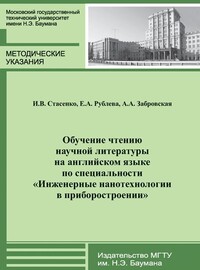Обучение чтению научной литературы на английском языке по специальности «Инженерные нанотехнологии в приборостроении»
Покупка
Тематика:
Английский язык
Год издания: 2013
Кол-во страниц: 48
Дополнительно
Вид издания:
Учебно-методическая литература
Уровень образования:
ВО - Бакалавриат
ISBN: 978-5-7038-3723-8
Артикул: 840465.01.99
Методические указания состоят из трех уроков (модулей), начинающихся базовыми текстами А и развивающими тему более развернуто текстами В и С. Каждый текст снабжен терминологическим словарем, облегчающим работу студентов с неадаптированной научной литературой, что особенно важно на начальном этапе учебного процесса. Грамматические упражнения стимулируют повторение сложных иноязычных конструкций с новым лексическим наполнением. Задания на составление плана текста и распределение его ключевых фрагментов в более упорядоченной логической последовательности позволяют выработать у студента первичные навыки аннотирования
и реферирования. Для студентов старших курсов факультета «Радиоэлектроника и лазерная техника», обучающихся по специальности «Инженерные нанотехнологии в приборостроении».
Рекомендовано Учебно-методической комиссией Научно-учебного комплекса «Фундаментальные науки» МГТУ им. Н.Э. Баумана.
Тематика:
ББК:
УДК:
- 621: Общее машиностроение. Ядерная техника. Электротехника. Технология машиностроения в целом
- 681: Точная механика. Автоматика. Приборостроение
ОКСО:
- ВО - Бакалавриат
- 11.03.01: Радиотехника
ГРНТИ:
Скопировать запись
Фрагмент текстового слоя документа размещен для индексирующих роботов
Московский государственный технический университет имени Н.Э. Баумана И.В. Стасенко, Е.А. Рублева, А.А. Забровская Обучение чтению научной литературы на английском языке по специальности «Инженерные нанотехнологии в приборостроении» Методические указания М о с к в а Издательство МГТУ им. Н.Э. Баумана 2 0 1 3
УДК 621.396.6
ББК 81.2 Англ-923
С77
Рецензент А. Г. Васильева
Стасенко И. В.
Обучение чтению научной литературы на английском
языке по специальности «Инженерные нанотехнологии в
приборостроении» : метод. указания / И. В. Стасенко, Е. А. Руб-
лева, А. А. Забровская. — М.: Изд-во МГТУ им. Н. Э. Баумана,
2013. — 42, [6] с. : ил.
ISBN 978-5-7038-3723-8
Методические указания состоят из трех уроков (модулей), начинающихся базовыми текстами А и развивающими тему более развернуто текстами В и С. Каждый текст снабжен терминологическим
словарем, облегчающим работу студентов с неадаптированной научной литературой, что особенно важно на начальном этапе учебного процесса.
Грамматические упражнения стимулируют повторение сложных иноязычных конструкций с новым лексическим наполнением.
Задания на составление плана текста и распределение его ключевых
фрагментов в более упорядоченной логической последовательности
позволяют выработать у студента первичные навыки аннотирования
и реферирования.
Для студентов старших курсов факультета «Радиоэлектроника
и лазерная техника», обучающихся по специальности «Инженерные
нанотехнологии в приборостроении».
Рекомендовано Учебно-методической комиссией Научно-учебного комплекса «Фундаментальные науки» МГТУ им. Н.Э. Баумана.
УДК 621.396.6
ББК 81.2 Англ-923
ISBN 978-5-7038-3723-8
МГТУ им. Н.Э. Баумана, 2013
С77
ПРЕДИСЛОВИЕ Целью данных методических указаний является обучение студентов старших курсов специальности «Инженерные нанотехнологии в приборостроении» разным подходам к извлечению информации при работе с оригинальными научными текстами. Таким образом, студенты должны овладеть различными уровнями проникновения в суть излагаемого материала, а также научиться точно переводить неадаптированную научную литературу по своей специальности и приобрести первичные навыки аннотирования и реферирования. Выбор тематики текстов (микроэлектромеханические системы — МЕМС) обусловлен необходимостью специализации в этой области студентов кафедры «Технологии приборостроения» (РЛ-6), а также признанием этого направления науки международным научным сообществом в качестве одного из наиболее перспективных в XXI в. Считается, что эта инновационная технология позволит произвести качественно новые, революционные изменения во многих областях науки, индустрии и производства. Мощный потенциал МЕМС в настоящее время уже обеспечивает технологический инновационный прорыв в области оптических телекоммуникаций, беспроводных средств связи, биомедицины, управления процессами и т. д. Основными и особыми преимуществами МЕМС являются их междисциплинарная природа, техника группового производства, делающие эту технологию даже более успешной, чем микрочипы интегральных схем. Перед проработкой каждого текста необходимо внимательно ознакомиться со словарем, предваряющим текст и содержащим терминологическую лексику. Следует выучить предлагаемые термины. Усвоение терминов создает предпосылки для дальнейшего беспереводного понимания научной литературы по изучаемой теме.
Послетекстовые упражнения подразделяются на следующие три типа: 1) упражнения на контроль понимания прочитанного, позволяющие концентрировать внимание на основных идеях, фактах, данных, явлениях, законах, выводах, точках зрения и т. д. с целью адекватной их передачи на русском языке; 2) разнообразные грамматические упражнения на распознавание и перевод сложных иноязычных конструкций. Эти упражнения построены на лексическом материале, взятом из оригинальных источников, и позволяют студентам повторить, распознать и правильно перевести грамматические конструкции, представленные в новом лексическом окружении. Авторы выражают большую благодарность доцентам кафедры РЛ-6 Е.А. Скороходову и К.В. Малышеву за консультации при подборе текстового материала.
INTRODUCTION Imagine a machine so small that it is imperceptible to the human eye. Imagine working machines no bigger than a grain of pollen. Imagine thousands of these machines batch fabricated on a single piece of silicon, for just a few pennies each. Imagine a world where gravity and inertia are no longer important, but atomic forces and surface science dominate. Imagine a silicon chip with thousands of microscopic mirrors working in unison, enabling the all optical network and removing the bottlenecks from the global telecommunications infrastructure. You are now entering the microdomain, a world occupied by an explosive technology known as MEMS (MicroElectroMechanical Systems). A world of challenge and opportunity, where traditional engineering concepts are turned upside down, and the realm of the “possible” is totally redefined. MEMS has been identified as one of the most promising technologies for the 21st century and has the potential to revolutionize both industrial and consumer products by combining silicon-based microelectronics with micromachining technology. If semiconductor microfabrication was seen to be the first micromanufacturing revolution, MEMS is the second revolution. Its techniques and microsystem-based devices have the potential to dramatically affect of all of our lives and the way we live. The term used to define MEMS varies in different parts of the world. In the United States they are predominantly called MEMS, while in Europe they are called Microsystem Technology. The micromechanical components are fabricated by sophisticated manipulations of silicon and other substrates using micromachining processes. Processes such as bulk and surface micromachining, as well as high-aspect-ratio micromachining selectively remove parts of the silicon or add additional structural layers to form the mechanical and
Похожие


